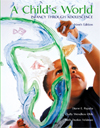 |  A Child's World: Infancy through Adolescence, 9/e Diane E. Papalia,
University of Wisconsin-Madison
Sally Wendkos Olds
Ruth Duskin Feldman
Forming a New Life
Learning Objectives
LEARNING OBJECTIVES FOR SECTION IAfter reading and reviewing this section of Chapter 3, you should be able to do
the following.
Explain why deciding whether or not to have children is more complicated
today than it was in preindustrial times.
Describe what happens during ovulation and fertilization.
Explain the difference between monozygotic and dizygotic twins and cite
factors affecting the incidence of each.
Give at least three common causes of infertility in men and in women,
and mention three common treatments.
Describe four methods of assisted reproduction and point out some of
the ethical questions involved.
Define cloning and discuss some ethical considerations involved.
|
 |  |  | After reading and reviewing this section of Chapter 3, you should be able to
do the following.
Tell what genes do and explain the significance of their location on
the chromosomes.
Distinguish between meiosis and mitosis and between monomorphic and
polymorphic genes.
Explain how the sex of a child is determined, and how and when an embryo
develops male or female characteristics.
Contrast dominant and recessive inheritance and explain how each occurs.
Tell why most normal traits are not the result of simple dominant or
recessive transmission?
Explain how a person can be either homozygous or heterozygous for an
expressed trait.
Explain the difference between a person's phenotype and that person's
genotype, and give an example.
Describe three methods of inheritance of defects, and give at least
one example of each.
Explain why defects transmitted by dominant inheritance tend to be less
deadly early in life than those transmitted recessively.
Name two ways in which chromosomal abnormalities can occur.
Identify the causes and characteristics of Down syndrome and discuss
the outlook for a child born with this disorder.
Tell how genome imprinting occurs and give an example of its effect.
Tell how a genetic counselor assesses the probability that a child
will be born with an inherited defect.
Discuss the benefits and risks of genetic testing.
|
 |  |  | LEARNING OBJECTIVES FOR SECTION IIIAfter reading and reviewing this section of Chapter 3, you should be able to do
the following.
Tell how researchers determine the heritability of a trait.
Describe three common types of studies of the influences of hereditary
and environmental factors in development.
Explain the concepts of reaction range and canalization, and give at
least one example of each.
Give an example of genotype-environment interaction.
Define and give examples of three types of genotype-environment correlation.
Explain why siblings tend to be more different than alike in intellect
and personality, and why each experiences a unique environment within the
family.
Assess the influences of heredity and environment on obesity, longevity,
intelligence, personality traits, temperament, shyness and boldness.
Identify the characteristics and probable causes of schizophrenia and
autism.
|
|



 2002 McGraw-Hill Higher Education
2002 McGraw-Hill Higher Education